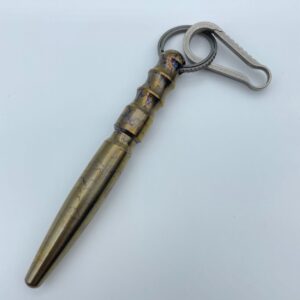No products in the cart.
Brass Knuckles for Self-Defense: Pros, Cons & Legal Risks
Part 1: Understanding Brass Knuckles and Their Role in Self-Defense
Brass knuckles, also known as knuckle dusters, are handheld weapons designed to fit around the fingers, concentrating the force of a punch into a compact metal frame. Historically, they emerged in the late 19th century as tools for close-quarters combat, favored by soldiers, laborers, and streetfighters for their ability to amplify striking power without requiring extensive training. Modern iterations are crafted from materials like steel, polymer, or zinc alloys, though traditional brass remains popular due to its balance of weight and durability.
As a self-defense tool, brass knuckles function by reducing the surface area of a punch, channeling kinetic energy into a smaller point of contact. This increases the likelihood of breaking bones, causing lacerations, or incapacitating an attacker. Their compact size allows for discreet carry, often fitting in a pocket or purse, though their effectiveness hinges on the user’s ability to deliver precise, close-range strikes. However, their use is fraught with controversy, straddling the line between personal protection and potential lethality.
Critically, brass knuckles lack the non-lethal designation of tools like pepper spray or stun guns. Their design inherently prioritizes offense over defense, raising ethical and legal questions about proportionality in self-defense scenarios. Understanding their mechanics is essential for anyone considering them as a protective option, as misuse can escalate violence rather than mitigate it.
Part 2: The Pros of Using Brass Knuckles for Self-Defense
Enhanced Striking Power
The primary advantage of brass knuckles lies in their ability to magnify impact force. By transferring the energy of a punch through a rigid frame, they reduce the risk of hand injuries (e.g., broken knuckles) while increasing damage to the target. This makes them particularly effective against larger attackers, where sheer force disparity might otherwise leave a defender vulnerable.
Ease of Use and Accessibility
Unlike firearms or even batons, brass knuckles require minimal training to wield effectively. Their simple design—gripping the handle and striking—makes them accessible to individuals without martial arts experience. Additionally, their affordability and widespread availability (in regions where legal) position them as an appealing option for those seeking immediate self-defense solutions.
Psychological Deterrence
The visible presence of brass knuckles can serve as an intimidation factor, potentially deterring an attacker from escalating a confrontation. The psychological impact of seeing a weapon designed for close combat may compel aggressors to reconsider their actions, buying critical seconds for escape or de-escalation.
Portability and Concealability
Weighing as little as 4–6 ounces, brass knuckles are easy to carry discreetly. Their flat profile allows them to be stored in a wallet, clipped to a belt, or worn around the neck, ensuring quick access in emergencies. This contrasts with bulkier options like expandable batons, which may be impractical for everyday carry.
Part 3: The Cons and Risks of Brass Knuckles
Legal Consequences and Ambiguity
The most significant drawback of brass knuckles is their legal status. Classified as deadly weapons in many jurisdictions, their possession or use can lead to felony charges, even if intended for self-defense. For example, states like California, New York, and Texas prohibit carrying brass knuckles outright, while others permit ownership but restrict concealed carry. Violations often result in hefty fines, confiscation, or imprisonment, complicating their role as a “protective” tool.
Risk of Severe Injury or Death
Brass knuckles’ capacity to inflict life-altering harm cannot be overstated. Strikes to the head, throat, or sternum can cause concussions, crushed tracheas, or cardiac arrest, potentially turning a defensive act into a manslaughter charge. This lethal potential undermines claims of proportional force in court, particularly if the attacker was unarmed.
Escalation of Violence
Introducing brass knuckles into a confrontation risks provoking an attacker to retaliate with equal or greater force. An assailant armed with a knife or firearm may perceive the knuckles as a lethal threat, justifying their own escalation. This dynamic can transform a survivable altercation into a deadly encounter.
Physical Limitations for the User
Brass knuckles require close proximity to an attacker, leaving little room for error. Missed strikes or grappling scenarios can render them ineffective, and their rigid design may hinder natural hand movements, reducing defensive agility. Additionally, improper grip or alignment during a punch can cause hand injuries, negating their protective purpose.
Part 4: Navigating the Legal Landscape
Variability in Regional Laws
The legality of brass knuckles is a patchwork of regulations that vary by country, state, and even municipality. In the U.S., federal law does not explicitly ban them, but states like Michigan and Illinois classify possession as a felony. Conversely, Arizona and Tennessee allow ownership but prohibit concealed carry. Internationally, countries such as the UK and Canada treat them as prohibited weapons, with penalties including imprisonment.
Concealed vs. Open Carry
Even in regions where ownership is permitted, concealed carry laws often criminalize hiding brass knuckles on one’s person. For example, in Florida, carrying them concealed without a permit is a first-degree misdemeanor, punishable by up to one year in jail. Open carry may be legal in some areas, but displaying them publicly can attract unwanted attention or accusations of intimidation.
Self-Defense Claims in Court
Using brass knuckles in a defensive scenario requires proving imminent threat of grave bodily harm. Judges and juries may view their use as excessive force, particularly if the attacker was unarmed. Legal precedents, such as People v. Grubb in California, have upheld convictions against individuals claiming self-defense, emphasizing the weapon’s inherently dangerous nature.
Ethical and Moral Considerations
Beyond legal risks, brass knuckles raise ethical questions about proportional response. Their design prioritizes injury over incapacitation, conflicting with the principle of using the minimum force necessary to neutralize a threat. This moral ambiguity can haunt users long after a confrontation, particularly if permanent harm is inflicted.
Part 5: Alternatives and Responsible Self-Defense Practices
Non-Lethal Defense Tools
For those seeking protection without legal or ethical pitfalls, pepper spray, tactical flashlights, or personal alarms offer effective alternatives. Pepper spray, for instance, can disable an attacker from a distance, reducing the need for close combat. Modern variants include UV-marking dyes to aid law enforcement in identifying assailants.
Self-Defense Training and Awareness
Investing time in martial arts (e.g., Krav Maga, Brazilian Jiu-Jitsu) or situational awareness courses builds confidence and skill without relying on weapons. Techniques like blocking, grappling, and de-escalation empower individuals to neutralize threats while minimizing harm to all parties.
Legal Consultation and Preparedness
Before purchasing any self-defense tool, consulting local laws is critical. Legal experts can clarify nuances, such as whether knuckle-based jewelry (e.g., “paperweight” designs) skirts restrictions. Additionally, understanding use-of-force statutes ensures actions align with regional self-defense frameworks.
Community and Technological Solutions
Apps like Noonlight or Citizen enable users to alert authorities or loved ones during emergencies, adding a layer of security. Community-based initiatives, such as neighborhood watch programs, foster collective safety, reducing reliance on individual weaponry.
By prioritizing risk-aware decision-making and exploring diversified strategies, individuals can protect themselves without incurring the legal, physical, or moral repercussions associated with brass knuckles. The key lies in balancing preparedness with responsibility, ensuring safety without crossing into lethality.











